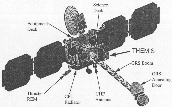|
Mars Surveyor 2001
Missions Take Shape
--- Athena Rover Will Carry Mini-TES ---
--- Orbiter Will Carry a TES-like Imaging System ---
by Ken Edgett, Arizona State University
Look out, Mars, here we come again, and again... and again!
On November 6, 1997, NASA announced science team selections for
the latest in the Mars Surveyor series-- the Mars Surveyor '01
Orbiter and the Mars Surveyor '01 Lander and Rover.
The biggest surprise for the Arizona State University (ASU) TES
group, headed by
Dr. Phil Christensen-- the 2001 missions will include new
instruments based on the Mars Global Suveyor TES project!
Mars Surveyor 2001 has three components-- an orbiter, a lander, and
a rover. Christensen's ASU team was selected to participate in the
rover and orbiter projects.
 Figure: Athena Rover diagram.
Figure: Athena Rover diagram.
Athena!
The rover is named Athena. The rover and lander are
planned to launch together in April 2001. The landing is slated
for January 2002. Athena has a lot in common with the
6-wheeled Sojourner that operated on Mars this past year,
but she is bigger and carries more science instruments. In fact,
Athena has a small drill to collect cores from rocks. These
rock samples might eventually be returned to Earth via a Sample
Return spacecraft that could reach Mars as early as 2006.
The leader of the Athena science team is Dr. Steve Squyres
of Cornell University (Ithaca, NY). Several years ago, Squyres
assembled a team to propose a rover for Mars. After several
proposals and much, much work, the rover was finally selected in
November 1997. It is planned to drive around for up to 365 days,
collecting and examining rocks at a site that has yet to be selected
(the hope is to pick a site of potential biological significance).
Mini-TES
The TES on Mars Global Surveyor (MGS) now has a child of
its own! Athena will carry a miniature version of TES,
smaller than a soda-pop can. The Mini-TES will be built by the
same people at Hughes Santa Barbara Remote Sensing (in Goleta, CA)
that built the MGS TES. Mini-TES will help the Athena team
select rocks to study and sample. Mini-TES is a project from ASU
and Dr. Christensen.
 Figure: 2001 Orbiter diagram.
Figure: 2001 Orbiter diagram.
2001 Orbiter and THEMIS
The Mars Surveyor '01 Orbiter is expected to launch in
March 2001 and reach the Red Planet in December 2001. It carries
two instruments linked to Arizona-- The Gamma Ray Spectrometer
(GRS) is from a University of Arizona team headed by Dr. William
Boynton. The GRS is a replacement of the similar instrument that
was lost on Mars Observer in 1993.
The other Arizona instrument is called THEMIS (Thermal
Emission Imaging System). THEMIS is headed by ASU's Christensen,
and will also be built by Hughes Santa Barbara Remote Sensing.
THEMIS can make thermal infrared images of Mars at resolutions of
about 100 meters per pixel (whereas TES has a resolution, at best,
of 3,000 meters per pixel). Like the MGS TES, THEMIS will map the
mineral composition of the martian surface-- only this time it will
do so with more detail than the TES currently in orbit.
THEMIS also includes a visible-light camera system that can
provide pictures of Mars at about 20 meters per pixel. This
additional camera is being provided by Malin Space Science Systems
(San Diego, CA). Like TES, THEMIS will be controlled at ASU in
Tempe, Arizona.
Beyond 2001
After the 2001 missions, another orbiter, lander, and rover
are being planned for launch in 2003. These are expected to
be followed by a mission in 2005 that will retrieve rocks
collected on Mars by Athena or the 2003 rover, and
bring the samples back to Earth by 2008. Depending on
funds, another Sample Return mission could follow.
TES News is published quarterly by the Arizona Mars K-12 Education
Program. This newsletter may be copied for EDUCATIONAL PURPOSES ONLY.
EDITED BY Kenneth S. Edgett, Arizona Mars K-12 Education Program,
Arizona State University, Tempe, Arizona, USA.
E-mail: ken.edgett@asu.edu
|



